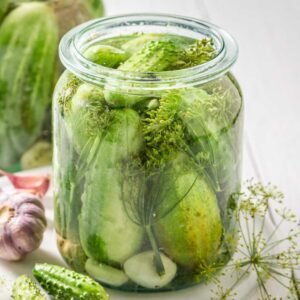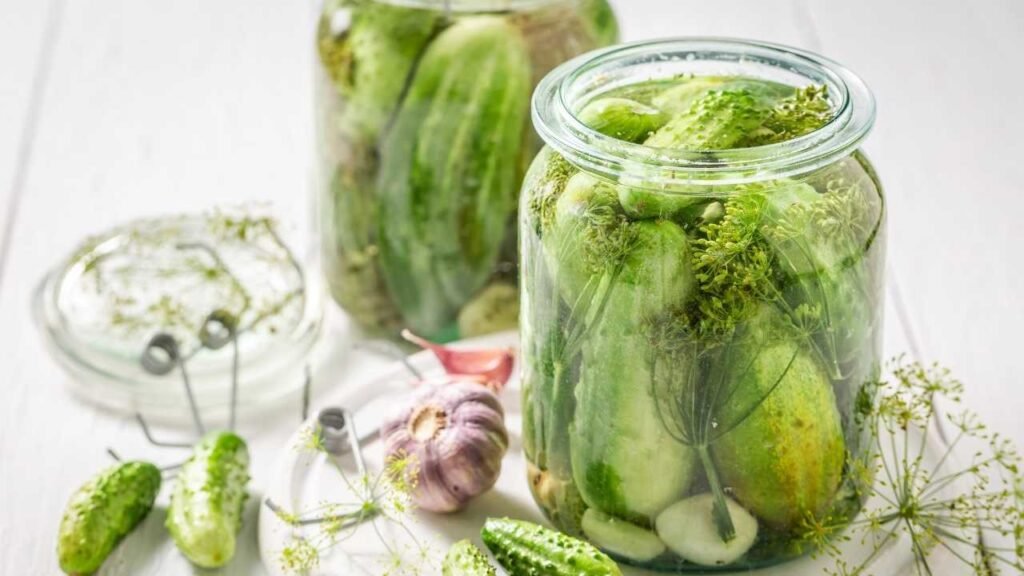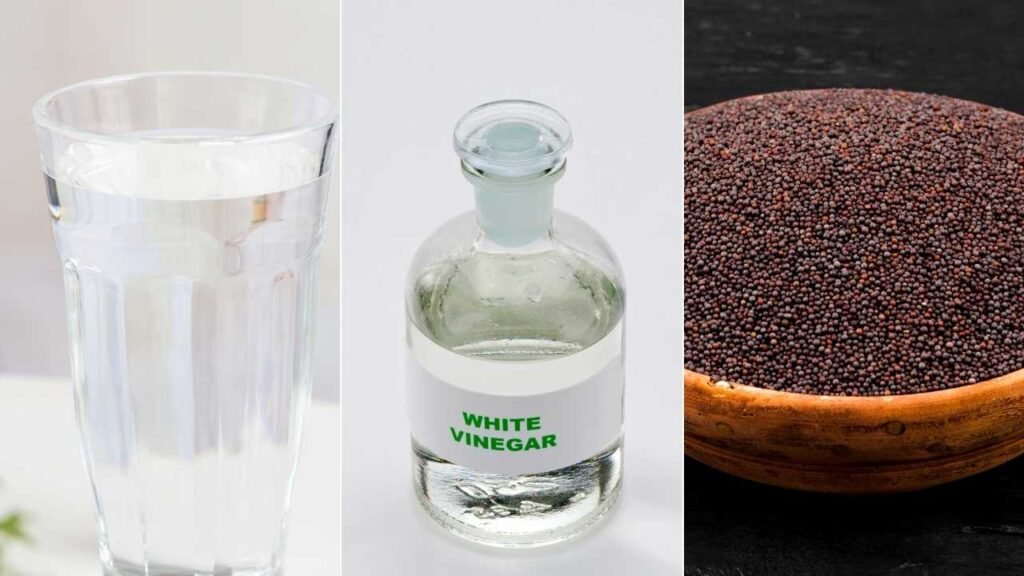I have experienced sudden leg cramps, especially after workouts and long runs, which made me feel too uncomfortable. That’s why I made Dill Pickle Juice.
This salty, tangy, briny liquid from my pickle jar is just the fastest, most natural way to ease those painful muscle cramps.
This homemade dill pickle juice isn’t only easy to make but also loaded with electrolytes, vinegar, and sodium.
How to Make Dill Pickle Juice for Cramps
Dill Pickle Juice is the liquid brine used to soak cucumbers and turn them into pickles — made with vinegar, salt, dill, garlic, and sometimes spices. It contains electrolytes and vinegar, which may help relieve muscle cramps and rehydrate your body faster.
Ingredients:
- 2 cups of water
- 1 cup white vinegar: You can use distilled or apple cider vinegar; both will work.
- 1 tbsp salt: I used the kosher salt, as it dissolves better.
- 1 tbsp dill seeds, or you can use 2 tbsp fresh dill sprigs
- 3–4 garlic cloves: I lightly smashed them.
- 1 tsp mustard seeds: Optional, but it adds depth
- 1 tsp sugar: It balances the acidity very well.
- ½ tsp black peppercorns
- 1 cucumber, sliced: It’s optional, if you actually want to make pickles with it.
Instructions:
- Add water, vinegar, salt, and sugar to your saucepan.
- Heat it on medium flame and stir until the salt and sugar dissolve completely.
- Remove from heat.
- Add dill, garlic, mustard seeds, and peppercorns. Stir gently.
- Let the mixture cool down to room temperature.
- Strain it if you prefer smooth pickle juice (for drinking).
- Store in a glass jar or bottle in the refrigerator for up to 2 months.
That’s it! Your homemade dill pickle juice for cramps is ready. Chill it before drinking — the coolness actually feels refreshing after a workout.
Ingredients Substitutes:
- Vinegar: Apple cider vinegar is milder than white vinegar. Moreover, it also adds gut-friendly probiotics.
- Salt: You can use Himalayan pink salt or sea salt, but make sure it’s not low-sodium — the sodium helps with cramps.
- Dill: Fresh dill gives a better aroma, but dried dill weed works fine too.
- Garlic: Optional — if you don’t like the strong smell, skip it.
- Sugar: Totally optional; you can use honey or omit it completely.
Why Pickle Juice Helps with Cramps
There’s actually some science behind this weird hack. Pickle juice has vinegar and salt in it. And they both work to restore electrolytes and re-trigger muscle relaxation.
Studies show that the acetic acid in vinegar helps your body produce acetylcholine, which tells muscles to relax.
That’s why many athletes prefer a quick pickle juice shot after running or training instead of sports drinks loaded with sugar.
If you like functional or recovery drinks, you might also love my Anti-Inflammatory Hot Chocolate Recipe.
Tips to Make Dill Pickle Juice Perfect
- Don’t boil for too long: Overheating kills the fresh dill flavor.
- Use filtered water: Tap water can make the brine cloudy.
- Chill before drinking: It will taste way better and reduce acidity (I chilled mine, not too much, I just kept it in the fridge for 30 minutes.
- Add cucumber: You can add just a few slices; it’ll turn your drink into actual pickles and juice.
- For athletes or runners, make a batch before long training days.
- You can store it in small glass bottles and keep them chilled, like mini pickle shots.
Variations to Try
Spicy Pickle Juice:
Add ½ tsp chili flakes or sliced jalapeños for a little kick. Perfect if you like heat with saltiness.
Sugar-Free Electrolyte Pickle Juice:
Skip the sugar, add a pinch of magnesium powder or lemon juice — this version is great for keto or low-carb diets.
Sweet Pickle Juice:
If you can’t handle too much salt, reduce the salt to half and increase the sugar slightly, more like a bread-and-butter pickle taste.
Turmeric Pickle Juice:
Add ½ tsp turmeric powder to make an anti-inflammatory version, inspired by this Turmeric and Coconut Milk Drink — great for sore muscles.
Garlic-Dill Recovery Drink:
If you actually enjoy the garlicky kick, leave the garlic in the jar overnight for a stronger taste.
What to Serve or Pair With Dill Pickle Juice
Savory Snacks:
- Pretzels — the saltiness pairs well with pickle tang.
- Roasted nuts or seeds — add crunch and healthy fats.
- Popcorn with a sprinkle of dill seasoning.
Post-Workout Foods:
- Grilled chicken or turkey wraps.
- Smoothies with coconut water or fruit for quick hydration.
- (Try my sprinkling coconut water recipe — great with pickle juice recovery days.)
Healthy Sides:
- Boiled eggs or tuna salad — protein boost with salty sips.
- Sweet potato chips or homemade baked fries — if you like a mix of salty-sweet recovery meals, check out dark chocolate sweet potato chipotle.
How Much Pickle Juice to Drink for Cramps
You don’t need a lot. Just 1–2 ounces (30–60ml) is enough to ease cramps in minutes.
Drink it right when the cramp starts, or post-workout if you sweat a lot.
If you’re someone who trains in hot weather or loses electrolytes quickly, keep a few pickle juice shots in your fridge.
(You can even freeze them in mini ice cube trays and pop one when needed.)
Also, if you love tangy hydration ideas, you’ll enjoy this Lemonade with Simple Syrup and Lemon Juice — more refreshing, less salty, perfect for alternating with pickle juice days.
Storage
Store your homemade pickle juice in a clean glass jar or bottle (never metal). It’ll stay good for up to 2 months in the fridge.
Shake well before every use because the spices settle down at the bottom.
If you want to extend shelf life, add an extra tablespoon of vinegar.
Benefits Beyond Cramps
This isn’t just for muscle cramps.
- Helps with hydration and electrolyte balance.
- It can reduce nausea after workouts.
- Some people claim it helps with menstrual cramps, too.
- It’s great for hangovers (yup, really).
- The vinegar supports gut health and digestion.
If you’re into recovery and energy-boosting drinks, you can also check out these related ones on the site:
Nutrition & Cost Breakdown (Approx per 2 oz serving)
- Calories: 10
- Sodium: 875mg
- Sugar: <1g
- Carbs: <1g
- Cost: Around $0.20 per serving (if homemade)
Keep in mind: Pickle juice is high in sodium — that’s what helps the cramps — but don’t overdo it if you have high blood pressure or sodium restrictions.
For most healthy adults, a few sips are totally safe and actually beneficial.
FAQs
How much pickle juice should I drink for cramps?
You don’t need a lot. Just take about 1–2 oz (around 30–60ml) when the cramp starts.
You can even take small sips before or after a heavy workout if you sweat a lot. Don’t drink from a big glass; it’s salty enough. A few sips do the magic.
Can I use store-bought pickle juice instead of homemade?
Yes, of course. If you already have a jar of dill pickles, that juice works fine too. Just make sure it’s real vinegar-based dill pickle, not the sweet or low-sodium kind.
Those don’t work the same for cramps.
Can I drink pickle juice every day?
You can, but not like a drink. Just a small shot daily if you lose electrolytes fast or live in a hot area.
Too much can add extra sodium, so I prefer small amounts when needed, not daily routine things.
Does pickle juice help only with leg cramps?
Nope, it can help with muscle cramps anywhere — calf, thigh, or even foot cramps.
Some people also say it helps with menstrual cramps, but mostly it’s used for muscle recovery after workouts or dehydration.

Dill Pickle Juice Recipe for Cramps
Ingredients
- 2 cups water
- 1 cup white vinegar or apple cider vinegar
- 1 tbsp salt kosher salt preferred
- 1 tbsp dill seeds or 2 tbsp fresh dill sprigs
- 3–4 garlic cloves lightly smashed
- 1 tsp mustard seeds optional
- 1 tsp sugar balances acidity
- ½ tsp black peppercorns
- 1 cucumber sliced (optional, if making pickles too)
Instructions
Make the Base Brine:
- Add water, vinegar, salt, and sugar to a saucepan.
- Heat on medium until salt and sugar dissolve completely.
Add Flavorings:
- Remove from heat. Stir in dill, garlic, mustard seeds, and peppercorns.
Cool & Strain:
- Let cool to room temperature.
- Strain if you prefer smooth pickle juice for drinking.
Store:
- Pour into a clean glass jar or bottle. Refrigerate up to 2 months.
Serve:
- Chill before drinking.
- Take 1–2 oz (30–60 ml) per serving as a recovery shot after workouts or runs.
Notes
- Don’t overheat — boiling kills dill’s fresh aroma.
- Use filtered water for clarity.

I’m a self-taught home cook who turns everyday ingredients into comforting, café-style recipes. I test everything in my own kitchen (sometimes more than once), tweak flavors how I like them, and share only what I actually enjoy.
Most of my recipes are chocolate-based or have a creative twist, and I keep them preservative-free, beginner-friendly, and fun to make.
If you love cozy drinks, healthier desserts, or bold flavor combos — you’re in the right place. [Read full story]











I guess it’ll work in digestion too